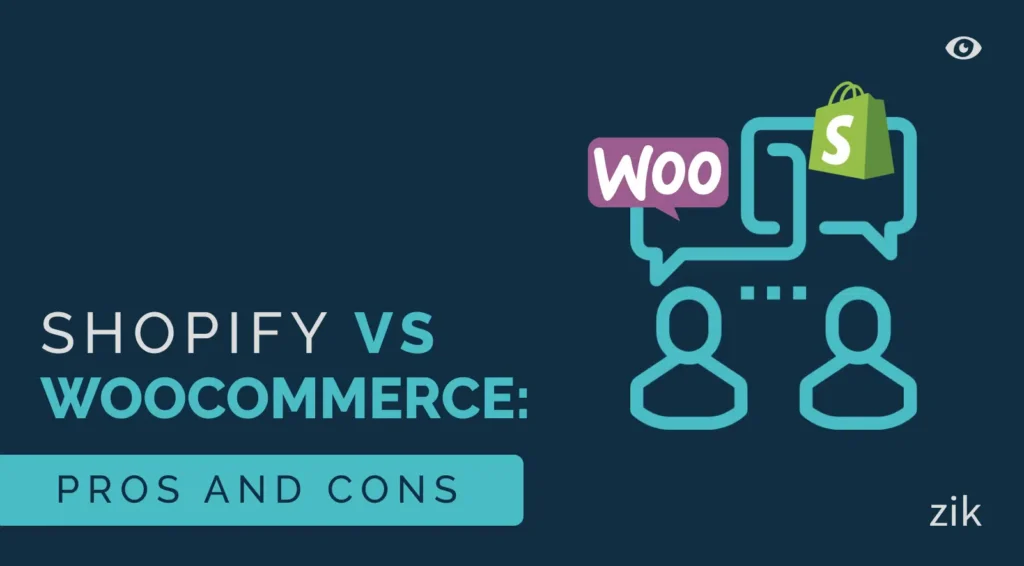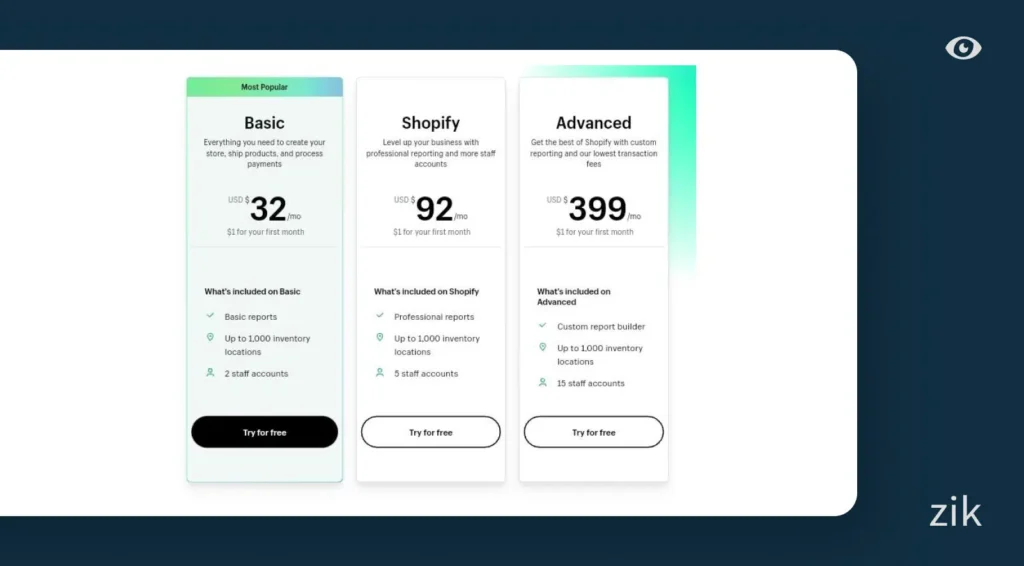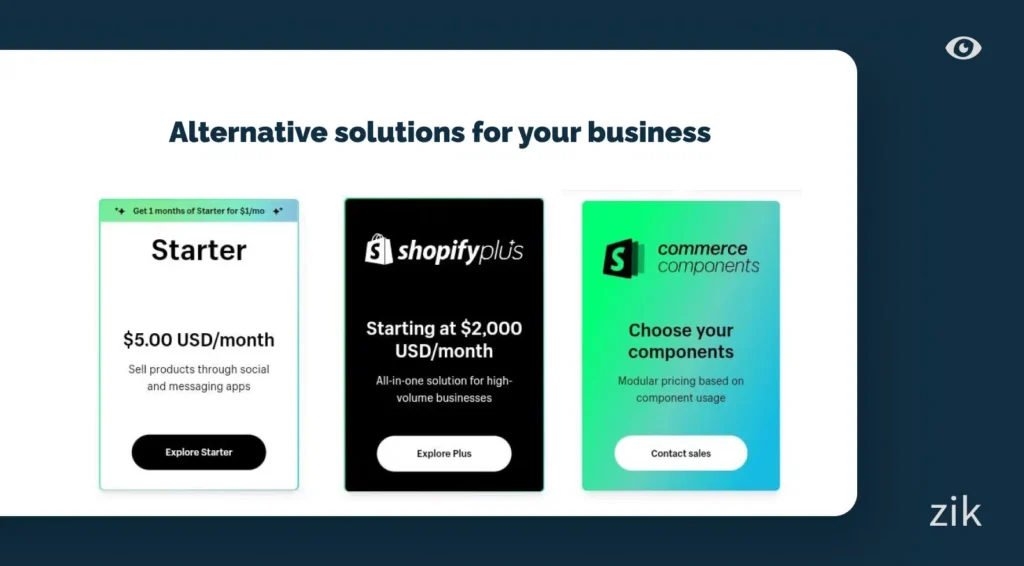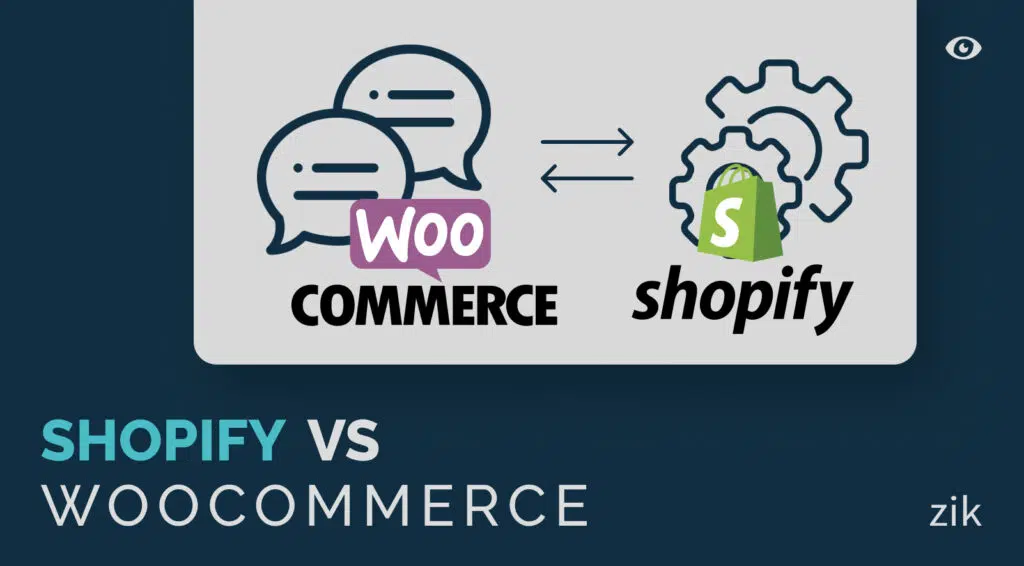In today’s world, the future of eCommerce looks promising, and with improved mobile users’ experience, personalized shopping experience, integrated technological tools, and shoppers gaining more control of their purchasing decisions, it has become more important than ever for businesses to have an online presence.
When it comes to selling online, choosing an eCommerce platform to host your online store is the major key factor to getting started. While you also need a target market, market plan, excellent customer service, and others, an online storefront that showcases your product helps to connect your brand with your target customers.
Shopify and WooCommerce are two ruling platforms businesses of all sizes are turning to build their own online stores. If you’re leaning toward Shopify, the ZIK Shopify AI store builder makes the process faster by helping you launch a fully built store in minutes, complete with product ideas and a professional layout
Therefore, if you want to know the best platform you can leverage to create your online store and meet your business needs and preferences, I’ve got you covered!
In this guide, you will learn how Shopify and WooCommerce work, in terms of pricing, features, ease of use, scalability, customization options, security, support, users’ experience, and overall performance. So you can determine the perfect go-to platform for your customers.

What Is Shopify?
Shopify is a fully-hosted e-commerce platform that provides businesses with an all-in-one solution for creating and managing an online store.
Since its inception in 2006, Shopify powered over 4.5 million live websites in more than 175 countries, with a total gross merchandise volume GMV of $27.52 billion, up by 25% year-over-year from $22.00 billion.
What is WooCommerce?
WooCommerce, on the other hand, is a free and easy solution for businesses to create an eCommerce store on WordPress. You can freely download the WooCommerce open-source plugin from the official WordPress plugin directory, create your website, showcase your products, and manage your orders with multiple payment gateways.
As of January 2023, WooCommerce hosts over 6.6 million active websites with a gross merchandise volume GMV of $11.8 billion. Moreso, 20.3% of WordPress users enjoy making use of the WooCommerce plugin to build their online store.
Both platforms have their advantages and disadvantages, and the choice between Shopify and WooCommerce ultimately comes down to the specific needs and preferences of the business.
Shopify vs Woocommerce: Pros and Cons

Shopify and WooCommerce are two of the most popular ecommerce platforms available today with their own unique strengths and weaknesses. Let’s compare the pros and cons of WooCommerce vs Shopify to decide which platform is right for your eCommerce business.
Shopify Pros
- Easy to use: Shopify is a fully hosted platform, which means that you don’t need to worry about maintaining servers, security, or software updates. The platform is easy to use with its drag-and-drop interface, even if you have no technical knowledge.
- Wide range of features: Shopify offers an all-in-one solution including built-in payment processing, shipping, and tax calculations, and customizable storefront designs. This makes it a great choice for most businesses, especially small-scale sellers who don’t have the resources to manage their own website.
- High volume businesses: Shopify allows large-scale businesses with high volume transactions to operate with any issues. It’s no doubt a great platform for scaling your business.
- Large integrated apps: The Shopify app store has over 6,000 apps with additional functionalities to effectively manage your store. A vibrant selection of apps and integrations within the Shopify ecosystem allows users to extend their store’s functionality, catering to specific business requirements.
- Excellent support: Shopify offers a 24/7 responsive support team via email, live chat, and phone. You can contact them for help if you run into any issues with your store.
Shopify Cons
- Selling fees: Shopify charges monthly fees based on your chosen plan, which can be a significant expense for small businesses starting with a low volume of sales. Shopify offers a basic Shopify plan for $32, a Shopify plan for $92, and you can also upgrade to the advanced plan for $399 per month with more available features. Also, you’ll get to pay a fee on each sale, which can be overwhelming for new sellers. Certain apps and integrations within Shopify’s ecosystem may incur extra fees, which can contribute to increased overall expenditure for store owners.
- Limited customization: While Shopify offers a range of customization options, you cannot design your store beyond the available features. Moreover, Shopify is a hosted platform, giving you less control over the technical aspects of your store. In some instances, you’ll have to hire a developer to make advanced customizations.
- Less control over hosting: As Shopify is a hosted solution, users have less control over their hosting environment and must rely on the platform’s infrastructure, which can impact store performance and scalability in some cases.
WooCommerce Pros
- Free and open-source platform: WooCommerce is a free and open-source platform that you can install on your own website. This gives you complete control over your store’s design and can customize it however you want.
- Large community: WooCommerce has a large community of developers that will help and inspire you to grow your eCommerce business and support you with the right resources and a wide variety of features.
- So Flexible: WooCommerce can be used to sell any type of product, including physical and digital products, subscriptions, and memberships.
- Easy set up: With the WooCommerce wizard setup, WordPress site content management systems, and available plugins, you can easily create and manage your Woocommerce store in little time.
- No transaction fees: WooCommerce doesn’t charge any transaction fees, which can save you money and increase your profits.
WooCommerce Cons
- Technical knowledge required: WooCommerce requires some technical knowledge to set up and manage. Store owners must manage several aspects independently, such as hosting, domain registration, and SSL certificates, which can be time-consuming and demanding for those less experienced in website management or don’t have the resources to hire a developer.
- Scalability issues: WooCommerce can have scalability issues if you have a large volume of traffic or transactions. You may need to optimize your server or use a content delivery network to handle the load.
- Limited support: While WooCommerce has a large community of users, it doesn’t offer the same level of support as Shopify. You may need to rely on forums and online resources for support.
- Payment processing: WooCommerce doesn’t offer built-in payment processing, so you’ll need to set up payment processing separately.
- Security: Because WooCommerce is self-hosted, you’re responsible for ensuring the security of your website. This can be a challenge if you’re not familiar with website security best practices.
- Maintenance responsibility: Users are responsible for maintaining their WooCommerce stores, including regular updates, backups, and security measures, which may be daunting for some.
- Potential costs for customization: While WooCommerce allows for extensive customization, premium themes, plugins, and developer fees can add to the overall cost of running the store, negating the initial cost advantage of the free plugin.
Shopify vs WooCommerce: Which is the Best Option For an Online Store
There are several key differences between the two platforms. Let’s take a closer look at the key differences between Shopify and WooCommerce so you can make the best choice.
Hosting and Performance
Shopify is a hosted e-commerce solution, meaning that hosting is included in their subscription plans. The platform handles all aspects of hosting, such as server maintenance, updates, and security, simplifying the process for store owners. Shopify also provides a fast and reliable hosting environment that ensures a smooth browsing experience for customers. The platform automatically scales to accommodate traffic spikes, helping maintain optimal site performance.
WooCommerce, on the other hand is a self-hosted solution, requires users to arrange their own hosting. Store owners must choose a hosting provider, manage server maintenance, and handle updates and security measures independently. The performance of a WooCommerce store largely depends on the chosen hosting provider and plan. High-quality hosting providers will deliver fast loading times and reliable uptime, but this can vary widely depending on the provider and the resources allocated to the store.
Shopify offers a more straightforward and hassle-free approach to hosting, with all aspects managed by the platform. This is ideal for users who prefer a hands-off experience and are willing to pay for the convenience of a hosted solution. WooCommerce, on the other hand, provides more control over hosting but requires a hands-on approach to managing servers, updates, and security. This is well-suited for those with technical expertise or store owners who prefer to have greater control over their hosting environment.
In summary, the choice between Shopify and WooCommerce as regards hosting will largely depend on the user’s desired level of control, technical skills, and preference for convenience.
Pricing
Shopify, with its subscription-based model, offers tiered pricing plans that encompass hosting, security, and a selection of design templates. Additionally, certain apps and integrations within Shopify’s ecosystem may incur extra fees, further increasing the overall expenditure.
In contrast, WooCommerce, as a free WordPress plugin, allows for greater cost control. Despite requiring users to handle hosting, domain registration, and SSL certificates independently, these expenses can often be acquired at competitive prices, potentially yielding a more economical solution. However, custom themes, premium plugins, and developer fees, if needed, may add to the overall cost.
Flexibility
Shopify presents a variety of themes and designs to choose from, making it possible to create a visually appealing storefront. However, customization options may be limited by the chosen theme’s inherent constraints. While Shopify does enable store owners to modify their sites, the scope of customization is somewhat restricted when compared to WooCommerce.
WooCommerce, on the other hand, grants users an unparalleled degree of flexibility when it comes to customization. As an open-source plugin built on the widely used WordPress platform, it allows for limitless modification possibilities. Entrepreneurs can choose from a vast array of themes, plugins, and extensions, or even create their own custom solutions. This adaptability empowers store owners to craft a truly unique e-commerce experience that aligns with their brand identity and goals.
Support
Shopify offers 24/7 customer support, while WooCommerce does not offer dedicated support. However, there are many resources available online for WooCommerce users, including user forums and developer communities.
App Store
Shopify has a large app store with many apps and plugins available to help you enhance your store’s functionality. WooCommerce also has a large library of plugins and extensions, but they are not all vetted by WooCommerce, so you may need to be careful when choosing plugins.
Ease of Set-up
Shopify emerges as the more accessible option for launching an online store, particularly for those with limited technical expertise. Its user friendly interface enables rapid store establishment. Conversely, WooCommerce provides unrivaled customization possibilities but demands a more complex setup, making it better suited for those familiar with WordPress or possessing a strong technical inclination.
Shipping and Dropshipping
Shopify offers a more streamlined and user-friendly experience, with built-in shipping options and popular dropshipping apps readily available. Shopify store owners can access discounted shipping rates with Shopify Shipping, which supports major carriers like USPS, UPS, and DHL. Shopify also has a rich ecosystem of dropshipping apps and integrations, such as Oberlo, Spocket, and Printful. This makes it a convenient choice for those who prefer a simplified approach.
WooCommerce, on the other hand, provides greater flexibility in configuring shipping options and connecting with dropshipping suppliers through various plugins. Popular shipping extensions include WooCommerce Shipping, which supports USPS and DHL, and plugins like ShipStation and Table Rate Shipping for more advanced shipping configurations. WooCommerce also supports dropshipping through various plugins, such as AliDropship, WooDropship, and Printful. This is an ideal choice for store owners who prefer more control and customization possibilities.
Get insider tips—download the eBook on Shopify competitor research now!Similarities Between Shopify and WooCommerce:
- E-commerce functionality: Both Shopify and WooCommerce are designed specifically for e-commerce and offer a wide range of features to help you set up and manage your online store.
- Payment processing: Both platforms offer multiple payment options, including credit cards, PayPal, and other third-party payment gateways.
- Integration with other platforms: Both Shopify and WooCommerce can be integrated with other platforms, such as accounting software, email marketing tools, and social media platforms.
- Customization: Both platforms allow you to customize the look and feel of your online store, including the use of themes, templates, and plugins.
- Scalability: Both WooCommerce and Shopify and can handle a wide range of store sizes, from small startups to large enterprises.
Where Can I Make More Money: Shopify or WooCommerce?
Shopify hosts over 1.75 million merchants worldwide with over $1 million in sales revenue. The platform also controls 32% of the eCommerce platform market.
WooCommerce on the other hand, is the most popular eCommerce platform used by over 4 million businesses worldwide.
However, do sellers on Shopify make more money than WooCommerce sellers?
To determine the amount you can make on either of the two platforms, you have to consider the cost of getting started while also keeping in mind additional costs for transactions, features, payments, marketing tools, and services.
Shopify offers a basic Shopify plan for $32, and a Shopify plan of $92, and you can also upgrade to the advanced plan for $399 per month with more available features.

There are also alternative solutions available like the Starter plan which you can start with at least $5. Here, you only get to sell products through your social and messaging apps.

In addition, your payment options also determine your profits during transactions. You can decide to use the Shopify payments method which charges 2.9% and 30 cents per transaction for the basic plan.
Shopify also offers third-party payments which charge a flat fee of 2.0% for all transactions. Though you can reduce the cost to 0.5% by upgrading to the Shopify Advanced plan.
So it’s clear that the highly-priced plans have loads of benefits!
From an average seller on Shopify making about $46,000, the top 10% make over $500,000 while the bottom 10% make less than $4,000.
WooCommerce offers a self-hosted platform with no additional charges. You’ll need a domain name, SSL certificate, and a web hosting account.
A domain costs between $10 to $20 per year and an SSL Certificate costs $60 per year. Hosting services like Bluehost offer free domain names, a free SSL certificate, and lower costs for WooCommerce hosting plans.
With the Bluehost WooCommerce setup wizard, you can kickstart your store for a reduced price of $2.75 monthly. Though you will have to purchase extensions for your store as your online store grows.
The cost to start on Shopify is more expensive than WooCommerce. The overall winner when it comes to earning and saving more is WooCommerce. However, making money on either platforms will depend on the marketing strategies you are implementing.
Conclusion
There you have it! A quick comparison between Shopify vs WooCommerce.
Shopify and WooCommerce both offer a range of features and benefits for e-commerce businesses. Shopify is best for businesses that want an easy-to-use, all-in-one solution, while WooCommerce is best for businesses that want complete control and flexibility over their store.
Both Shopify and WooCommerce offer robust shipping and dropshipping solutions. The choice between the two platforms largely depends on the entrepreneur’s preference for simplicity and ease of use or a more customizable and hands-on approach.
Therefore, your choice between these two platforms will depend on your specific needs, budget, technical expertise, and goals for your online store. However, with the help of this guide, there’s no doubt that you’ll be able to decide the right platform for use and keep generating more revenue for your business.
Find Winning Shopify Products with AdSpy
Choosing Shopify over WooCommerce? Make smarter product decisions from day one with the Shopify AdSpy. It shows you what’s trending, what’s selling, and what your competitors are advertising, so you can launch with proven winners. Skip the guesswork and start with data-backed insights that drive real sales.
Frequently Asked Questions About Shopify vs WooCommerce
Here are some fequently asked questions about Shopify vs WooCommerce:
Is it worth moving from WooCommerce to Shopify?
It can be worth it if you want easier maintenance, reliable hosting, simpler support, and faster store setup. Shopify handles security, updates, and server issues for you. But if you value full control, customization, and lower costs at scale, WooCommerce may still be better.
What are the downsides of WooCommerce?
WooCommerce requires more technical management since you handle hosting, security, and updates yourself. Costs can rise with premium themes, plugins, and developer help. It also demands ongoing maintenance, which may overwhelm beginners seeking simplicity, making it less user-friendly compared to hosted solutions like Shopify.
Is WooCommerce no longer free?
No, WooCommerce is still free as a plugin you can install on WordPress. However, running a full-featured WooCommerce store often incurs costs for a domain, hosting, premium themes, SSL, paid extensions, and payment gateways.
Is WooCommerce slower than Shopify?
WooCommerce can be slower than Shopify, but it’s not always the case. Shopify uses its own managed infrastructure, built-in CDN, automatic caching, and performance optimizations, giving faster average load times. WooCommerce speed depends heavily on your hosting, theme, plugins, and how well it’s optimized.
Why choose WooCommerce over Shopify?
Choose WooCommerce if you want full control, deep customization, and ownership of your store on WordPress. It’s more cost-flexible with plugins and open-source freedom, making it ideal for developers or businesses seeking tailored solutions. Unlike Shopify, you’re not locked into monthly fees or platform limitations.
Does WooCommerce take a cut of sales?
No, WooCommerce itself does not take a cut of your sales since it’s free and open-source. However, you’ll still pay fees charged by your chosen payment gateways like PayPal or Stripe, as well as hosting and extension costs needed to run the store.
Does WooCommerce report to IRS?
No, WooCommerce does not directly report to the IRS because it’s an open-source WordPress plugin, not a payment processor. However, payment gateways you connect to, like PayPal or Stripe, may issue 1099 forms if you meet reporting thresholds, so income is still taxable.
Is Shopify safer than WooCommerce?
Yes — Shopify tends to be safer out of the box because it’s a hosted platform that handles hosting, SSL, PCI-compliance, and security updates for you automatically. In contrast, WooCommerce (on WordPress) gives you more control but also more responsibility for securing your site, keeping plugins up to date, and choosing a reliable host.
Does WooCommerce have a monthly fee?
No, WooCommerce itself has no monthly fee since it’s a free WordPress plugin. However, running a WooCommerce store usually involves ongoing costs for web hosting, domain, SSL, and premium themes or plugins. These expenses effectively act like monthly or annual operating fees.
Want to review our other Shopify comparison articles?
Check out our comparisons of Shopify vs:
- Big Cartel
- BigCommerce
- Ecwid
- Magento
- Neto
- OpenCart
- osCommerce
- PrestaShop
- shopify plus
- Squarespace
- Volusion
- Weebly
- Wix
- WordPress













